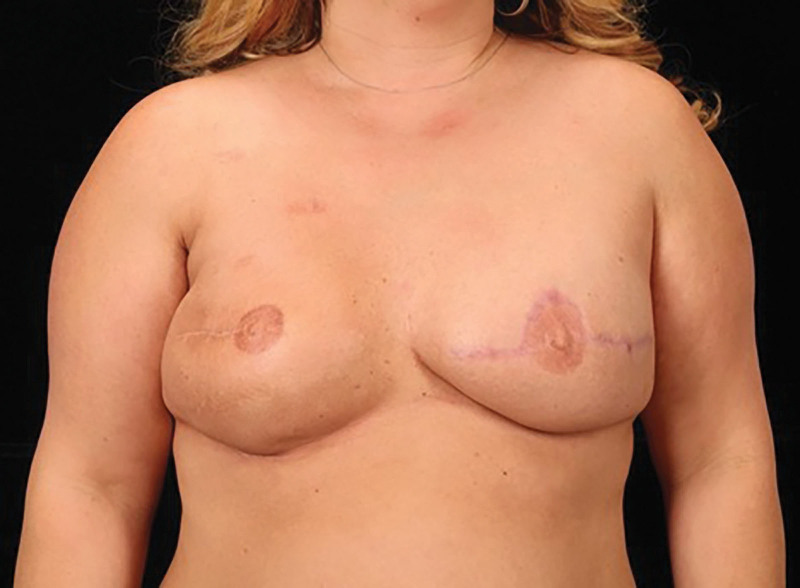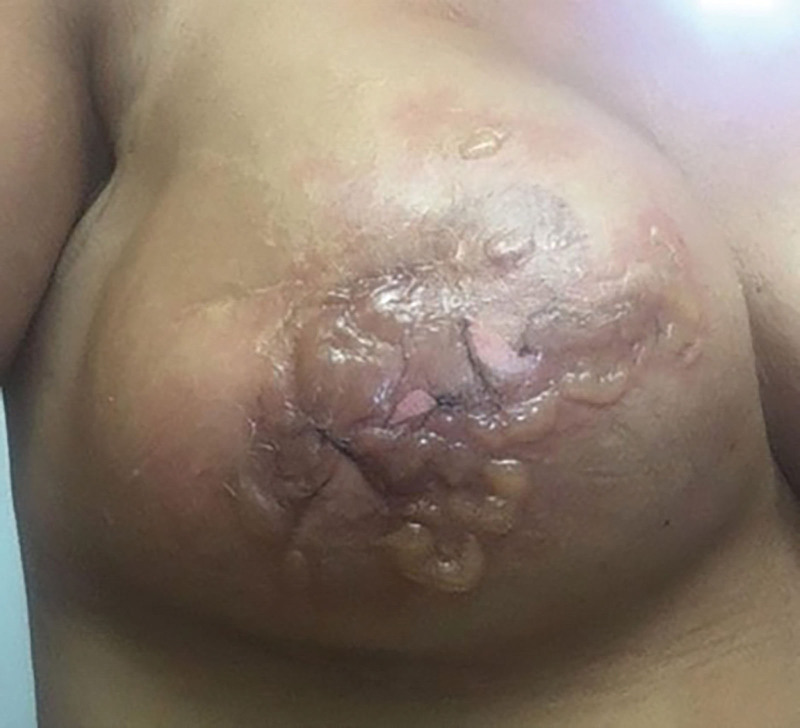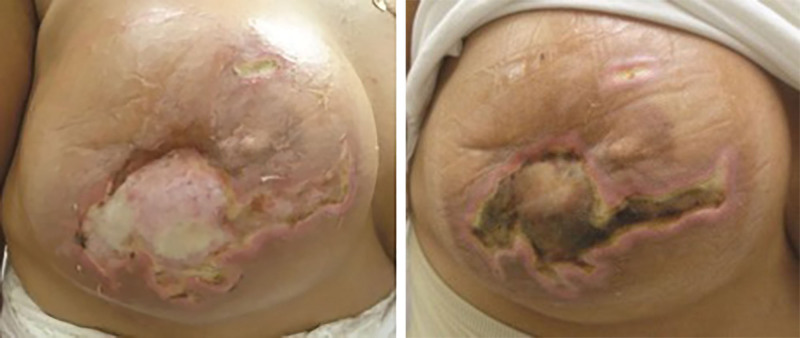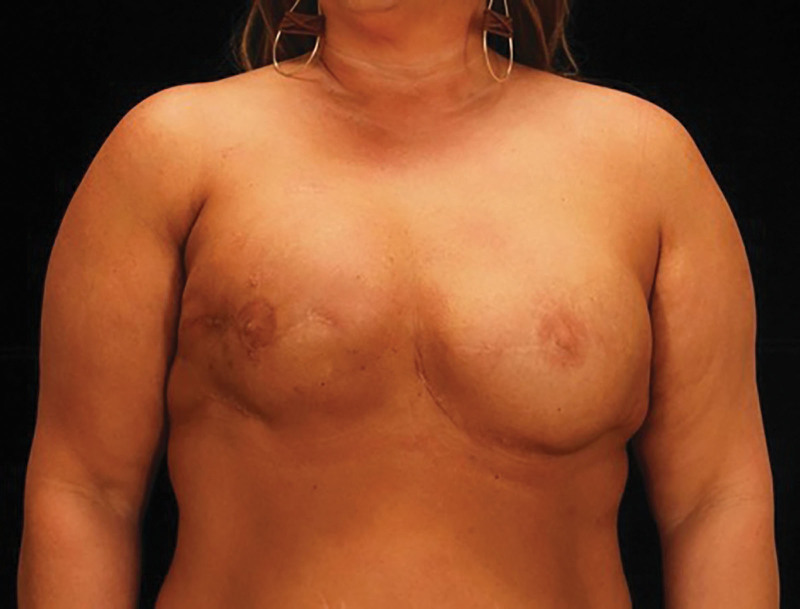Background:
Burns to the breast are a rare complication after breast reconstruction. Decreased sensation and radiation therapy may contribute to the development of burns. Solar burns may also be related to wearing dark-colored clothing. This literature review aims to analyze the incidence of solar burns on alloplastic and autologous breast reconstruction following mastectomy. Also included is the first published report of a delayed breast burn years after alloplastic reconstruction.
Methods:
A PubMed literature search of articles was performed using the search formula “burns” AND “breast reconstruction.” Abstracts were evaluated for relevance based on inclusion and exclusion criteria. Pertinent reference bibliographies were then screened for additional relevant resources.
Results:
The PubMed search resulted in 598 articles, of which 12 met inclusion criteria with 22 cases of solar burns to reconstructed breasts (23 including the addition of our case report). Five occurred following alloplastic reconstruction with 80% of these patients radiated and 100% wearing dark clothing. The remaining 18 patients had autologous reconstruction with 50% wearing dark clothing. Twenty-two percent of patients in the autologous group required surgical debridement as compared to 40% of the alloplastic group.
Conclusions:
Solar burns in autologous and alloplastic breast reconstruction, while rare, pose significant complications in the reconstructed breast and appear to be exacerbated by radiation and dark-colored clothing. Patients should be counseled accordingly with discussion of this potential risk in a comprehensive informed consent, and precautions should be recommended to avoid this type of injury.
Takeaways
Question: What risk factors are associated with solar burns in breast reconstruction?
Findings: Solar burns presented with higher incidence following autologous breast reconstruction, history of radiation, and dark clothing. Alloplastic breast reconstruction required surgical debridement more frequently than autologous breast reconstruction.
Meaning: Breast reconstruction patients should be counseled regarding the incidence, complications, and risks of solar burns.
INTRODUCTION
The radiated, reconstructed breast is susceptible to postsurgical complications with the majority of these occurring in the immediate perioperative period. Burns to the reconstructed breast, while rare, can present as a delayed complication resulting from contact/conductive, radiant, or solar exposure.1 Solar burns have been described as the second most common cause of burns in both autologous and implant-based breast reconstruction in the literature.2
The most common form of breast reconstruction to date is alloplastic, or implant-based reconstruction (IBR) which may be performed in either an immediate or delayed fashion. Although rates in autologous breast reconstruction have remained consistent over the years, implant use has increased an average of 11% per year.3 Reports of burns in IBR suggest these may be the result of etiologic factors including tissue expansion and radiation.
Unfortunately, burns are rarely cited as a complication in the literature outside of case reports, case series, or letters to the editor. This is possibly because most burns are superficial (first degree) and of no consequence; however, they have potential to be devastating. Early versions of the American Society of Plastic Surgeons (ASPS) informed consent forms for breast reconstruction mentioned a generic caution to avoid sun exposure and suggested the use of sunscreen or covering with clothing.4 This statement has been removed from more recent forms, including the 2020 ASPS informed consent forms for both autologous and alloplastic breast reconstruction.5 In addition, there is no recommendation to avoid certain clothing colors or the potential to be burned through clothing.
Herein, we include a literature review of solar burns to the reconstructed breast to help determine risk factors and increase awareness of this rare potential complication. In addition, we describe a case of full-thickness solar burn to the breast 8 years after IBR. The method of reconstruction included fat grafting to improve skin quality, repeat expansion, and replacement of implant.
PATIENTS AND METHODS
A literature search was performed to identify publications regarding solar burns in autologous and alloplastic breast reconstruction. The PubMed search engine was used; key words included “burn” AND “reconstructed breast.” The abstracts of the articles were screened, and the articles not relevant to burns on the breast following breast reconstruction were excluded. All publications with solar burns in autologous or IBR were included. Solar burns included those caused by sunbathing or by sun lamp. Autologous breast reconstruction included patients who underwent deep inferior epigastric perforator (DIEP) flap, free or pedicled transverse abdominis musculocutaneous (TRAM) flap, or latissimus dorsi (LD) flap. Thoracodorsal artery perforator (TAP) flaps with implant and acellular dermal matrix were also included and characterized as autologous breast reconstruction. IBR included patients who received direct to implant or tissue expander followed by implant without any regional or free flaps. Literature reviews, case reports, case series, and letters to the editor were included. Excluded were patients without burns on the breast or those caused by other methods such as conduction (heating pads, hot water bottles, or hot liquids) or convection (hair dryers and warming lamps). Additionally, non-English articles were excluded. In the remaining articles, review of the bibliography for each article resulted in additional relevant articles.
Data gathered included patient’s age, reconstructive method, history of radiation therapy, time from reconstruction to burn, duration of sun exposure, type of clothing, burn thickness, burn description, burn treatment, and outcome. In publications that satisfied our inclusion criteria but with limited or missing data, the data were included if available.
CASE REPORT
We present the case of a 41-year-old, healthy, nonsmoking woman with Fitzpatrick type 3 skin who developed right-sided invasive ductal carcinoma and underwent bilateral skin-sparing mastectomy and reconstruction with subpectoral tissue expander placement. The initial surgery was followed by 12 weeks of adjuvant chemotherapy and 28 fractions of radiation (50.4 Gy of radiation localized to the right breast and chest wall, 45 Gy localized to the right supraclavicular fossa and posterior axilla). Eight months after the initial surgery, the tissue expanders were exchanged with 750-mL smooth, round implants. She then underwent nipple areolar complex reconstruction with CV flaps followed by tattoo. Four years later, due to continued radiation changes, she underwent minor revision of the right breast with capsulotomy and lowering of the inframammary fold (Fig. 1).
Fig. 1.
Patient’s final reconstruction 2 years before burn injury. This image was 2 years postoperative from nipple areolar complex reconstruction with CV flap and tattooing and lowering of the left inframammary fold.
Postoperatively, she did well until 4 years after her last surgery (eight years after the initial surgery). The patient sat in the sun in a new black-colored polyester bathing suit for approximately 2 hours. That evening, she noticed severe blistering on the right breast mound in the area that was covered up by the bathing suit (Fig. 2). She was wearing sunscreen over the remainder of her skin and had no burns elsewhere including the exposed, also irradiated, skin surrounding the bathing suit, or the contralateral breast. She presented to the emergency department that evening and to clinic 3 days later where she was diagnosed with a partial thickness burn. This was managed initially with Xeroform and bacitracin dressing changes, however, the burn progressed to full-thickness (Fig. 3). Due to the large area of full-thickness burn and subjective fevers, the patient was offered excision of the burn with reconstruction using autologous versus staged IBR.
Fig. 2.
Patient self-image of the right breast wound the same evening as the sun exposure. The blistering is contained to the skin that was covered by the black bathing suit.
Fig. 3.
The patient’s right breast burn progressed to full-thickness by 12 days postinjury. Over a 2-month period, this became swollen and tender and was not healing, requiring debridement and reconstruction.
The patient wished to undergo surgery with IBR. To get her closer to her preoperative size, we discussed the need for repeat expansion as well as fat grafting to improve the quality of the radiated skin. The burn was excised and the breast implant was removed. Fat was harvested from her abdomen using liposuction. The fat was separated with Telfa (Covidien llc, Mansfield, Mass.) and 138 mL was injected into the mastectomy skin flaps and pectoralis muscle using a Coleman technique. The mastectomy flaps were closed primarily over a partially filled tissue expander.
The patient underwent several rounds of tissue expander filling in the office and 2 months later she returned to the operating room for removal of the expander with placement of smooth round implant. Repeat fat grafting with 20 mL of abdominal fat was performed on the right breast as well as a left-sided Ryan flap and implant exchange for symmetry. The patient went on to heal with no major complications. Her wounds healed and she had improved pain and symmetry (Fig. 4).
Fig. 4.
The patient’s final photograph following reconstruction. The right breast burn was debrided, fat grafting was performed, and the breast was closed over a tissue expander. After expansion was complete, the expander was replaced with a smaller implant and more fat grafting was performed. The left breast implant was exchanged for a smaller implant and a Ryan flap was performed for inframammary fold symmetry.
RESULTS
The literature search identified 598 publications. Review of the abstracts revealed 27 relevant articles. Twenty-two cases of solar breast burns after reconstruction were identified from 12 articles. The mean age of all patients was 51 years old. The age of the patient population ranged from 24 to 71 years old.
Eighteen of the 23 (78%) solar burns were described in autologous breast reconstruction. Of the autologous flaps, 11 (61%) were TRAM flaps, four (22%) DIEP flaps, two (11%) TAP flaps, and one latissimus (6%). Most of the TRAM flaps were pedicled (9; 82%). Ten of the 23 (43%) solar burns occurred in the first 6 months, and an additional eight (78%) patients developed solar burns which occurred within the first 2 years. Fourteen of these patients (78%) went on to heal within 3 weeks to 4 months; however, four patients (22%) required surgical debridement with skin grafting. Nine patients (50%) were noted to be wearing dark clothing, two were wearing no clothing, and seven are unknown or not documented.
Five solar breast burns (22%) occurred in patients after alloplastic breast reconstruction. The four cases in the literature (80%) occurred within 7 months of the patient’s reconstructive surgery; however, in the case we described, this occurred 8 years after her implant placement. Two burns occurred over a tissue expander (40%) and three over a permanent implant (60%). Four of the five alloplastic cases (80%) received radiation (with the other undocumented) and two (40%) required implant removal and further surgical reconstruction. All five of these burns (100%) occurred through the patient’s dark-colored clothing.
DISCUSSION
Solar burns to the breast after reconstruction remain a rare, often overlooked, and potentially devastating complication after breast reconstruction. Susceptibility of the breast to thermal injury is likely multifactorial, including factors such as radiation, history of tissue expansion, and clothing color.18 Perhaps, the most important factor common to most solar burns in reconstructed breasts is a dark-colored garment. The color black absorbs all wavelengths of light and reflects none; thus, more energy is absorbed. The darker the color, the more heat is generated against radiated, expanded, or insensate skin which is already less equipped to handle these thermoregulatory challenges. Radiation causes DNA damage and histologic changes in the skin and soft-tissue microvasculature, leading to impaired thermoregulatory response to heat stress.6 Additionally, tissue expansion can decrease the thickness of the dermis, possibly altering the ability of the flaps to resist heat.19
Limited or absent sensation of the skin following breast reconstruction is thought to be due to the sacrifice of sensory nerves during the mastectomy, which therefore reduces the patient’s ability to detect solar heat.19 Some mastectomy flaps partially regain protective sensation over the course of a few years, but this recovery is variable and unpredictable.20 A comparison of nipple-sparing mastectomy has shown improved light touch and pleasure sensation relative to skin-sparing mastectomy, which could lead to a reduced incidence of thermal injury in nipple-sparing mastectomy relative to skin-sparing mastectomy.21 Unfortunately, our literature review possessed limited data with regard to the type of mastectomy.
Incidence of solar burns in the literature was found to be higher in autologous breast reconstruction when compared with implant-based reconstruction based on our findings illustrated in Table 1. Within autologous reconstruction, DIEP flaps recover in the most sensate manner, followed by TRAM flaps, and then LD flaps.22 One hypothesis proposed is the delay in neural healing across the thickness of autologous flap tissue relative to implant-based reconstruction with tissue expanders.23 This could also be explained by the improved sensation in implant-based reconstruction relative to autologous breast reconstruction.24,25 One proposed explanation for this is due to nerves’ more rapid growth through native tissue when compared with crossing through to the flap.26 The lack of neural regeneration early in the reconstructive process may be why previous reports suggest solar burns in IBR are an earlier postoperative complication (within first 6 months). Some patients such as those described in this report, however, may not regain complete sensation, leaving them susceptible to such injury even years later.20
Table 1.
Summary of Peer-reviewed Literature of Solar Burns in Autologous and Implant-based Breast Reconstruction
| Reference | Year | Patient Age, y | Reconstructive Method | Radiation Therapy | Reconstruction to Burn Time | Method of Exposure | Duration of Exposure | Type of Clothing | Burn Thickness | Burn Description | Treatment | Time to Healing |
|---|---|---|---|---|---|---|---|---|---|---|---|---|
| Maxwell & Tornambe7 | 1989 | 48 | Pedicled TRAM | Unknown | 1 y | Sunlamp | Unknown | No clothing | Partial | L breast | Topical silvadene BID with debridement | 3 mo |
| 54 | Pedicled TRAM | Unknown | 5 y | Sunlamp | Unknown | No clothing | Partial | L breast | Topical silvadene BID with debridement | 1 mo | ||
| Lejour8 | 1996 | Unknown | Unilateral implant | Yes | 7 mo | Sun exposure | N/A | Dark clothing | Full | 4 cm diameter | Implant exchange, LD | Unknown |
| Unknown | TRAM flap | Unknown | Unknown | Sun exposure | Unknown | Unknown | Partial | Unknown | Dressing changes | Unknown | ||
| Alexandrides et al9 | 1997 | 53 | Pedicled TRAM | Unknown | 1 y | Sun exposure | Unknown | Black, polyprolene | Full | 8 cm diameter | Topical Silvadene, healed by secondary intention | Unknown |
| Unknown | Pedicled TRAM | Unknown | 2 wks | Sun exposure | Unknown | Black polyester | Full | Unknown | Topical bacitracin and Keflex | 6 wks | ||
| Unknown | Pedicled TRAM | Unknown | 4 mo | Sun exposure | 3 h | Black polyester | Partial | 3 × 4 cm | Silvadene and dressing changes, healed by secondary intention | Unknown | ||
| Beckenstein et al10 | 1997 | 42 | Bilateral pedicled TRAM | Unknown | 10 d | Sun exposure | Unknown | Black bathing suit | Deep partial | 48 and 44 cm2 | Excision and split-thickness skin graft | Unknown |
| 44 | Unilateral pedicled TRAM | Unknown | 10 mo | Sun exposure | 40 min—no sunscreen | Unknown | Partial | 6 cm2 | Topical antibiotic ointment, healed by secondary intention | 3 wks | ||
| Nahabedian & McGibbon11 | 1998 | 24 | TRAM | Unknown | 6 mo | Sunbathing | Unknown | Dark clothing | Full | 2 × 6 cm | Conservative–dressing changes | Unknown |
| Davison12 | 1999 | 52 | Pedicled TRAM | No | 10 mo | Sun exposure | Unknown | Bathing costume | Full | Overlying flap | Dressings; permanent scarring | 6 wks |
| Delfino et al1 | 2009 | 44 | Pedicled TRAM | Yes | 8 mo | Sun exposure | Some hours | Black polypropylene | Full | Lateral surface, 6 × 4 cm | Dressing changes and topical chloramphenicol/collagenase | 2 mo |
| 45 | Textured saline tissue expander, submuscular | Unknown | 5 mo | Sun exposure | 20 min | Black polyester | Full | Inferior flap 12 × 8 cm | Dressing changes with paraffin gauze | 4 mo | ||
| 66 | Tissue expander | Yes | 6 mo | Sun exposure | 2 h | Black polypropylene | Full | Inferior flap 7 × 5 cm | Dressing changes with paraffin gauze | 3 mo | ||
| Enajat et al13 | 2009 | 54 | DIEP | Unknown | 6 wks | Sun exposure | 1 h | Shirt | Deep partial | Unknown | Treated conservatively | weeks |
| 55 | DIEP | Unknown | 2 mo | Sun exposure | Unknown | White shirt | Full | 5 × 5 cm | Debridement and split thickness skin graft | Unknown | ||
| 43 | DIEP | Unknown | 18 mo | Sun exposure | Unknown | Two piece bathing suit | Unknown | Unknown | Infected, treated with antibiotics | Unknown | ||
| Mahajan et al14 | 2010 | Unknown | LD | Unknown | Unknown | Sun exposure | Unknown | Reading glasses over a thin black top | Unknown | Unknown | Unknown | Unknown |
| Børsen-Koch et al15 | 2016 | 61 | TAP flap, 375 mL silicone implant and ADM (TAPIA) | No | Unknown | Sun exposure | Unknown | Black T-shirt | Full | Unknown | Debridement, split-thickness skin graft | Unknown |
| 48 | TAPIA, 365 mL Becker implant | No | 4 wks | Sun exposure | Unknown | Dark shirt | Full | 8 × 6 cm | Debridement, negative pressure wound therapy. Full-thickness skin graft | Unknown | ||
| Nigro et al16 | 2018 | 71 | Direct to implant textured silicone implant, prepectoral with ADM | Yes | 7 wks | Sun exposure | 45 min | Black camisole | Full | Unknown | Daily wound care including hydrogel, hydrofera blue, and aquaphor with hyperbaric oxygen therapy | Unknown |
| Saadeh et al17 | 2020 | 64 | DIEP—R, unilateral | Yes | 2 y | Unknown | Unknown | Unknown | Deep partial | 6 × 2 cm, central | Local wound care, hydrogel | Unknown |
| Romanelli et al (current study) | 2021 | 41 | Submuscular tissue expander, smooth round implants | Yes | 8 y | Sun exposure | 2 h | Black polyester | Full | 13 × 6.5 cm | Excision with primary closure, fat grafting and staged implant-based reconstruction | 4 mo |
One limitation of this study is the potential for reporting bias given the nature of the systematic review of prior literature. This could also be the reason for our increased incidence of solar burns in autologous breast reconstruction. Additionally, our study was limited in that prior studies did not characterize whether skin-sparing or nipple-sparing mastectomy had been performed before reconstruction.
In conclusion, although there are few reports of sunburn following IBR, this problem will continue to occur with the increase in breast reconstruction without proper informed consent. IBR remains the most common type of breast reconstruction and patients must realize that complications can extend beyond the immediate perioperative period. Patients should be aware that this potential complication can occur years after reconstruction. Solar injury to the skin is a known harm, but appears to be of greater risk in breast reconstruction patients lacking protective sensation. High-risk patients, such as those with radiated skin and less than 1 year out from surgery, should apply sunscreen to unexposed skin, avoid dark clothing over the breasts, and diligently check their skin even after short periods of exposure to the sun. Although a rare complication, we believe the incidence and prevention strategies of potential burn injury should be included in informed consent for both implant-based and autologous breast reconstruction.
Footnotes
Published online 13 May 2022.
Disclosure: The authors have no financial interest to declare in relation to the content of this article.
REFERENCES
- 1.Delfino S, Brunetti B, Toto V, et al. Burn after breast reconstruction. Burns. 2008;34:873–877.. [DOI] [PubMed] [Google Scholar]
- 2.Jaeger M, Wagman Y, Liran A, et al. A literature review of burns in reconstructed breasts after mastectomy. Wounds. 2016;28:422–428.. [PubMed] [Google Scholar]
- 3.Albornoz CR, Bach PB, Mehrara BJ, et al. A paradigm shift in U.S. breast reconstruction: increasing implant rates. Plast Reconstr Surg. 2013;131:15–23.. [DOI] [PubMed] [Google Scholar]
- 4.2009. ASPS informed consent. Available at https://nam04.safelinks.protection.outlook.com/?url=https%3A%2F%2Fwww1.plasticsurgery.org%2Finclude%2Fdocuments%2FICR%2FICR_TOC_17446.pdf&data=04%7C01%7Caidan.derrico%40wolterskluwer.com%7Ceab4a423aec54f5ed65a08da0d907c52%7C8ac76c91e7f141ffa89c3553b2da2c17%7C0%7C0%7C637837211936940143%7CUnknown%7CTWFpbGZsb3d8eyJWIjoiMC4wLjAwMDAiLCJQIjoiV2luMzIiLCJBTiI6Ik1haWwiLCJXVCI6Mn0%3D%7C3000&sdata=b%2FUPkbw%2FV%2B9IQ9kYanadPqi9Kzx2INNDyBwFTnyaF8I%3D&reserved=0. Accessed March 21, 2020.
- 5.2020. ASPS informed consent. Available at https://nam04.safelinks.protection.outlook.com/?url=https%3A%2F%2Fwww1.plasticsurgery.org%2Finclude%2Fdocuments%2FICR%2FICR_TOC_17446.pdf&data=04%7C01%7Caidan.derrico%40wolterskluwer.com%7Ceab4a423aec54f5ed65a08da0d907c52%7C8ac76c91e7f141ffa89c3553b2da2c17%7C0%7C0%7C637837211936940143%7CUnknown%7CTWFpbGZsb3d8eyJWIjoiMC4wLjAwMDAiLCJQIjoiV2luMzIiLCJBTiI6Ik1haWwiLCJXVCI6Mn0%3D%7C3000&sdata=b%2FUPkbw%2FV%2B9IQ9kYanadPqi9Kzx2INNDyBwFTnyaF8I%3D&reserved=0. Accessed March 21, 2020.
- 6.Doll C, Durand R, Grulkey W, et al. Functional assessment of cutaneous microvasculature after radiation. Radiother Oncol. 1999;51:67–70.. [DOI] [PubMed] [Google Scholar]
- 7.Maxwell GP, Tornambe R. Second- and third-degree burns as a complication in breast reconstruction. Ann Plast Surg. 1989;22:386–390.. [DOI] [PubMed] [Google Scholar]
- 8.Lejour M. Burn of a reconstructed breast. Plast Reconstr Surg. 1996;97:1306–1307.. [DOI] [PubMed] [Google Scholar]
- 9.Alexandrides IJ, Shestak KC, Noone RB. Thermal injuries following TRAM flap breast reconstruction. Ann Plast Surg. 1997;38:335–341.. [DOI] [PubMed] [Google Scholar]
- 10.Beckenstein MS, Beegle PH, Hartrampf CR, Jr. Thermal injury to TRAM flaps: a report of five cases. Plast Reconstr Surg. 1997;99:1606–1609.. [PubMed] [Google Scholar]
- 11.Nahabedian MY, McGibbon BM. Thermal injuries in autogenous tissue breast reconstruction. Br J Plast Surg. 1998;51:599–602.. [DOI] [PubMed] [Google Scholar]
- 12.Davison JA. Burns to reconstructed breasts. Ann R Coll Surg Engl. 1999;81:19–22.. [PMC free article] [PubMed] [Google Scholar]
- 13.Enajat M, Rozen WM, Audolfsson T, et al. Thermal injuries in the insensate deep inferior epigastric artery perforator flap: case series and literature review on mechanisms of injury. Microsurgery. 2009;29:214–217.. [DOI] [PubMed] [Google Scholar]
- 14.Mahajan AL, Chapman TW, Mandalia MR, et al. Sun burn as a consequence of resting reading glasses on a reconstructed breast. Breast J. 2014;20:543–544.. [DOI] [PubMed] [Google Scholar]
- 15.Børsen-Koch M, Gunnarsson GL, Sørensen JA, et al. Thermal injury in TAPIA breast reconstruction-thermal injury to thoracodorsal artery perforator flap. Gland Surg. 2017;6:110–113.. [DOI] [PMC free article] [PubMed] [Google Scholar]
- 16.Nigro LC, Feldman MJ, Blanchet NP. Burn in an irradiated prepectoral breast reconstruction: a cautionary tale. Plast Reconstr Surg Glob Open. 2018;6:e1874. [DOI] [PMC free article] [PubMed] [Google Scholar]
- 17.Saadeh R, Naga N, Mesdag V, et al. Unusual burn injury to a deep inferior epigastric perforator flap reconstructed breast. Breast J. 2020;26:526. [DOI] [PubMed] [Google Scholar]
- 18.Kay AR, McGeorge D. Susceptibility of the insensate reconstructed breast to burn injury. Plast Reconstr Surg. 1997; 99:927. [DOI] [PubMed] [Google Scholar]
- 19.Delfino S, Brunetti B, Toto V, et al. Does tissue expansion increase skin susceptibility to thermal injury? A physical model. Burns. 2009;35:1054–1055.. [DOI] [PubMed] [Google Scholar]
- 20.Chan JK, Yap LH. The anatomical basis of desensitization in breast reconstruction: comment on “Burn after breast reconstruction” by Delfino S., et al. [Burns 34 (2008) 873-877]. Burns. 2009;35:1050–1052.. [DOI] [PubMed] [Google Scholar]
- 21.Akdeniz Dogan Z, Farhadi J. Evaluation of sensation on mastectomy skin flaps following immediate breast reconstruction. J Reconstr Microsurg. 2020;36:420–425.. [DOI] [PubMed] [Google Scholar]
- 22.Khan A, Zhang J, Sollazzo V, et al. Sensory change of the reconstructed breast envelope after skin-sparing mastectomy. Eur J Surg Oncol. 2016;42:973–979.. [DOI] [PubMed] [Google Scholar]
- 23.Shridharani SM, Magarakis M, Stapleton SM, et al. Breast sensation after breast reconstruction: a systematic review. J Reconstr Microsurg. 2010;26:303–310.. [DOI] [PubMed] [Google Scholar]
- 24.Bae JY, Shin HY, Song SY, et al. Risk and protective factors affecting sensory recovery after breast reconstruction. Arch Plast Surg. 2021;48:26–32.. [DOI] [PMC free article] [PubMed] [Google Scholar]
- 25.Benediktsson KP, Perbeck L, Geigant E, et al. Touch sensibility in the breast after subcutaneous mastectomy and immediate reconstruction with a prosthesis. Br J Plast Surg. 1997;50:443–449.. [DOI] [PubMed] [Google Scholar]
- 26.Bijkerk E, van Kuijk SMJ, Beugels J, et al. Breast sensibility after mastectomy and implant-based breast reconstruction. Breast Cancer Res Treat. 2019;175:369–378.. [DOI] [PMC free article] [PubMed] [Google Scholar]






